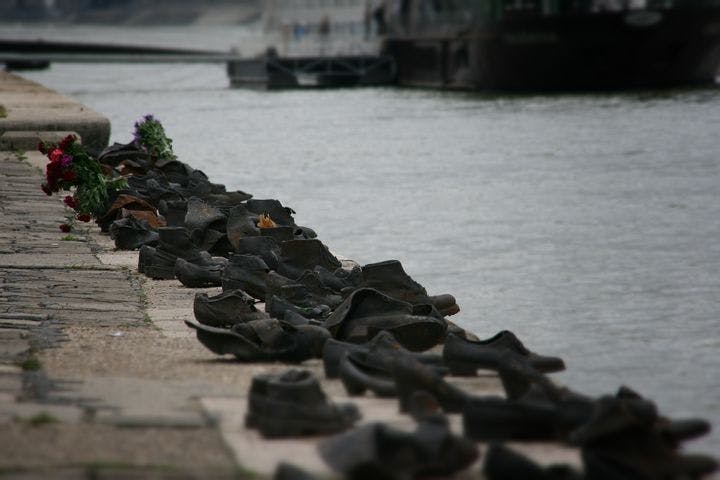Fall 2008
Victims of War
– Hew Strachan
Hew Strachan on Targeting Civilians in War: "Desperation drives even democracies to target civilians in order to coerce the enemy to surrender."
During the 20th century, Alexander B. Downes tells us, between 43 and 54 million noncombatants died as a result of war. However shocking, it is a statement without precision. As he acknowledges, we have no firm bead on the civilian death toll in Iraq, let alone in the many conflicts of sub-Saharan Africa. The military losses of World War I are known to the nearest million, the civilian losses not even to so general an estimate. And how are we to define a combatant? Downes decides to treat the terms “noncombatant” and “civilian” interchangeably, though a few military personnel, such as doctors, are noncombatants, and many civilians are combatants.
Neither point contradicts the basic premise of Downes’s book, that civilians have been targeted in modern interstate wars, and that this has been a problem of increasing international concern. Downes, a political scientist at Duke, argues that the pressure to target civilians has arisen in two types of war: those of territorial annexation, in which enemy civilians are displaced or killed to make way for settlers, and wars of attrition, in which desperation drives even (or particularly) democracies to target civilians in order to coerce the enemy to surrender. In Downes’s view, the types of regime engaged in the war are not significant, nor is either military culture or the racial identity of the enemy. Downes is a reductionist, anxious to seek a single set of explanations for a complex phenomenon.
Desperation drives even democracies to target civilians in order to coerce the enemy to surrender.
He develops four principal case studies: the blockade of Germany in World War I, the strategic bombing of Japan (but not of Germany) in World War II, the conflict of 1947–49 associated with the founding of Israel, and the South African War of 1899–1902. In the latter conflict, the British decision to collect Boer families in “concentration” camps was less innovative than first appearances suggest. Though colonial annexation relied on assimilation more than
ethnic cleansing, these wars still targeted the indigenous populations, because these populations sustained their warriors in the field. When the British invaded Zululand in 1879, they destroyed its agricultural base and sacked its capital, Ulundi: Women and children were not exempt from the consequences of that offensive, though Downes appears to believe they were.
The legacy of colonial warfare is an important strand in the argument about the origins of 20th-century “total war.” The British again waged economic warfare when they blockaded the Central Powers in World War I. Downes is forgiving if civilian deaths were caused unintentionally, for example by the sanctions imposed on Iraq in the 1990s. Though he does not acknowledge it, many of the consequences of Britain’s blockade were also indirect and unanticipated. Downes attributes the fall in German food production solely to the effects of the blockade, overlooking the role the Germans themselves played in diverting agricultural labor to wartime mobilization efforts, mismanaging food distribution, and failing to understand the market. He ascribes all German excess civilian deaths, due especially to tuberculosis, to malnutrition. Finally, Downes concludes that the blockade contributed to the German decision to seek an armistice in 1918, though the choice was made by the German high command in response to the military situation.
Fortunately, most will read this book not for what it has to say about Germany, but for its argument that, at least until 1970, a democracy was as likely to target civilians as was any other type of regime (including the Nazis’), particularly in protracted wars. Downes is on surer ground when he examines the U.S. bombing of Japan during 1944–45 and the wars fought in 1947–49 during Israel’s founding, both of which buttress his conclusion that domestic norms against the killing of civilians are, at best, secondary considerations in explaining how democracies choose to fight.
But there is a case for saying that—at least in the two world wars—regime type was a more important factor than Downes allows. British propaganda in World War I drew a distinction between the German people and the Kaiser. The logic of the blockade was that starvation might provoke revolution, and so effect a change in government. Believing that this was what had happened in 1918, the Allies hoped for the same effects when they bombed Germany in 1944. Hitler proved them wrong. Nonetheless, similar arguments were voiced in advance of the invasion of Iraq in 2003. Democracies have targeted civilians at least in part because they believe in the power of the people to overthrow tyrannical governments.
Finally, Downes needs to consider what makes a democracy fight a protracted war. As he rightly observes, no sensible democratic leader will knowingly undertake a long, bloody, and indecisive conflict. In the first half of the 20th century, democracies fought long wars because they saw themselves as defending core values, and so both military and moral imperatives justified breaching the principle of noncombatant immunity.
* * *
Hew Strachan is Chichele Professor of the History of War and a fellow of All Souls College at the University of Oxford, where he directs the Leverhulme Program on the Changing Character of War. His most recent book is Clausewitz’s On War: A Biography.
Reviewed: Targeting Civilians in War by Alexander B. Downes, Cornell University Press, 315 pp, 2008.
Photo courtesy of Flickr/emilstefanov
